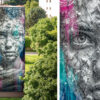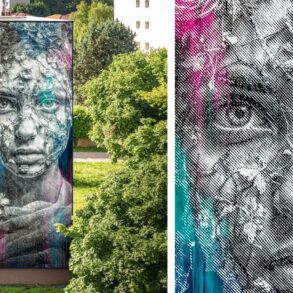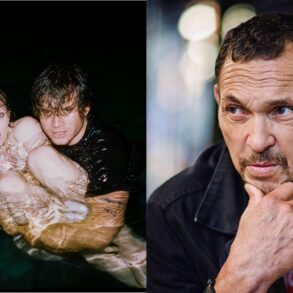This is the sixth post in our fourth season of Philly Street Art Interviews! This season is sponsored by Philadelphia International Airport (PHL) and its @PHLAirportArt program, which curates museum-quality art exhibitions that introduce millions of visitors from around the world to the vibrant artistic culture of the region. PHL proudly supports Philly arts and culture/365! Interview and photos by Streets Dept Lead Contributor Eric Dale.
If you’ve ever seen an arrangement of glass pieces hanging from a fence in Philly, you’ve had the opportunity to be transformed by the power of light, thanks to stained glass street artist Justin Tyner.
I was certainly transformed by Justin’s work—one of his installations is among the first 20 non-commissioned artworks I ever photographed in Philly, and I credit its unexpected nature with playing a big part in drawing me into the world of street art. Because really, when you think about it, it’s absolutely magical that someone is using this medium for public art. How great is Philly?!
To hear him talk about his artistic practice and values today, it’s no surprise that Justin makes street art. But you won’t believe how his first foray came about. And he decided to take this interview full circle by installing the piece in these photos at the same location as his very first one.
Streets Dept Lead Contributor Eric Dale: Let’s start with your beginnings, because I think the story of how you got into street art is one of the most unusual ones I’ve encountered. If I recall correctly, you created your first public installation… because a pair of French filmmakers… basically asked you to?
Justin Tyner: That’s right, yeah. And otherwise, I probably wouldn’t have even tried it.
SD: So tell me about that whole thing.
JT: So I guess the origin of that is from Art in the Open, where they invited 30 or so artists to bring their studios or art practice out into the open of Philadelphia [to make] public art. It was along the Schuylkill River Banks. And I built a giant stained glass window outside, while people were walking by, for three days. It was like a spinning kaleidoscope. And I guess these French filmmakers found me through that. And they just randomly—I want to say they called me on my landline in 2012. And that’s why I always answer every phone call. Haha! Because you never know. So they called me and they invited me to do this. I told them I never did street art before, I just did this public art thing, and they said we don’t care; we just want you to do something and we’ll film you all day long as you build it.
I never knew it was going to be real until we met face to face at FDR Park. So they traveled around, I guess, all through Europe, in the capital cities in Europe, filming street artists. Then they came to the States and they did Chicago, DC, and Philly. And I, along with Ishknits and Nosego, were the three artists they picked—and that’s pretty good company, if you ask me, right?
So when they were here, I took them to FDR park, and we collected the bottoms of beer bottles where all the skaters were. Then we went straight to Capitolo [Playground] and I actually constructed this thing on site, and then put it up on the fence. I thought that’s what street art is, like, you put it out into the public and you let it go. And that’s what happened, so that’s how that came about.
SD: Wow. So why do you think they chose you to represent Philadelphia?
JT: I was making art at the time, but I wasn’t making, like, public street art. And I think they were intrigued because it was stained glass and it was unusual to see stained glass as street art. I think that’s why they did it. And then after I put it up, I think I reached out to Conrad, or somehow we connected, and it just kind of went off from there. I did another one, and then another one, and then years later—
SD: You caught the bug?
JT: I caught the bug. Still doing it!
SD: Something that I think makes your work stand out is the contrast between the context in which people normally experience the medium of stained glass, and the context that you place it in. What do you hope to achieve by moving such a traditionally religious medium out into the street?
JT: Okay, so I’m coming at it as a stained glass artist and putting my own spin on it. Like, I’ve been trained as a traditional stained glass artisan. I’m putting my own spin on it because I’m using those traditional methods and technique to build it, but I’m putting it in public spaces to get that same feeling one would get in a church, but not in a church. It’s totally out of context. The subject matter is not the same as in a church, but the light shining through it and activating the glass—that’s where the power of stained glass is. So I’m using that light in my own way to express myself and to express my point of view as a stained glass artist.
SD: Is there any religious aspect to that for you?
JT: I would say just light shining through the glass can give you a sense of comfort, just the way that it was intended in the first place. So I hold that dear. Light itself is kind of like a sacred thing to a lot of people. There’s light versus dark, good and evil, that sort of thing.
SD: Yeah, I’ve seen you describe light as “transformative.”
JT: For sure. I mean, this is getting a little bit heady, but you can think about light as a comfort for you—if you’re putting thought and intention into it, which I’m doing.
SD: You reclaim a lot of the glass in your work from real churches that have been abandoned or demolished. What is that process like?
JT: It is a time-consuming process. I look at it as: artists a hundred years ago were placing these stained glass windows in the churches for a purpose, right? And as time goes by and for many different reasons, churches close down, and the need for those windows dissipates. And so I’m trying to use the original intention of those artists in a new way, and keeping that intention moving forward, just in a different way. But what I’m using is the discarded glass in the restoration process. I’m using that and giving it a new life.
SD: And you only get that from the company that you work with; you don’t go out and collect your own church glass, right?
JT: Right, yeah. It’s all part of the restoration process through Beyer Studio, which is a stained glass studio in Germantown, which I’ve worked for for the past 24 years now. I started right out of art school. Didn’t know anything about stained glass, but they were looking for an artist/construction worker, and that kind of fit my skill set. So I’ve learned everything on the job, traveling all over the country, visiting countless churches in and around Philadelphia and in the Tri-State area. And so I’ve grown to really have a passion for stained glass art.
SD: Do you have a favorite piece of glass or a favorite source of glass?
JT: A favorite piece of glass… I mean, I think there’s value in how old something is—that it could survive. So the older it is, I put more value on that. But I also favor delicious, bright colors. Every color of the rainbow you could make out of glass. There’s different styles of glass: German glass, French glass, English glass, American-made glass. I think English streaky—we’re getting into real technical stuff here—but that’s one of the standards. And there’s a few glass blowers out there now that are trying to mimic those old colors and styles of glass. But I love it all.
SD: So no. No favorite piece of glass. Haha!
JT: No, I couldn’t nail one down!
SD: So you mentioned that you use traditional tools and materials and methods, and I love that about you. Is that important to you personally, or is it just that making stained glass has not evolved in 200 years?
JT: Oh, that’s a great way to put it. It hasn’t evolved much besides, you know, plugging in your soldering iron or something. But I also hold value in tradition. I mean, if it ain’t broke, don’t fix it.
SD: I’ve also seen that you bend real lead around pieces of glass—with your bare hands. That, to me, as a layperson, seems, like, dangerous, right? Is that a safe thing to do?
JT: I’m working with clean materials, I’m not working with hundred-year-old lead. And if I do use [something hazardous], I take precautions. I wear gloves and a respirator, and I have a ventilated workspace.
SD: Is this lead right here?
JT: Yeah. But this is clean lead.
SD: What does that mean?
JT: It’s brand new. It hasn’t had a chance to oxidize.
SD: So the oxidization is what is dangerous?
JT: Exactly. So, if I touch this with my bare hands, and I wash my hands, I’m good. If this is a hundred years old, and it starts to crumble, and I breathe that in, that’s no good. So I take precautions.
SD: Okay. Huh. So why do we use lead for stained glass?
JT: Because it’s the strongest material that’s pliable. You can’t bend harder metals. I guess they use zinc sometimes, but that’s not flexible. And lead has an inherent strength to it; that’s why it lasts so long.
SD: So I look at this and I say why not copper? Copper is bendable! But you’re saying copper isn’t strong enough—because the glass is so heavy and that’s why it needs to be so strong?
JT: Yeah, I mean, if we’re talking stained glass in churches, it’s constantly fluctuating through different temperatures; sun and not sun; and weather and that sort of thing. So it expands and contracts, and the lead gives a little bit and takes a little bit. Over years and years, it deteriorates, but it does last a hundred years, and longer if it’s sealed properly and all that.
But there is that copper foil [technique]. It’s like copper tape.
SD: Copper tape?
JT: So it’s this technique—I guess Louis Tiffany pioneered this. And this technique is, like, what hobbyists use. I’m not knocking it—it’s fine. It’s just not the traditional method. It’s become popular. A lot of people are using stained glass, and using copper foil and doing really cool stuff with it that you couldn’t do with lead. So there’s positives and negatives. It won’t last as long, and it’s not as strong, but when you’re coating the whole piece in a solder, it gives it the strength.
And they’re making lead-free lead. It doesn’t have the elements of the poison in it, I guess, but it’s not as good. It doesn’t bend as well. There’s different styles, I guess, of construction of these windows. There’s a disconnect between fine art, craft, and hobby in the glass world, where if you’re the traditionalist, you’re not using the copper foil because your grandma’s making sun catchers with it. And then the copper foil artists are like well, we don’t like how toxic lead is, so we work with this material instead. But, you know, it’s still toxic when you’re soldering anything, really, if you don’t wear proper protection.
But I use both; I don’t have those biases. I think whatever gets you through is fine by me.
SD: I think that’s a good attitude to have! Okay, so tell me about your residency in France.
JT: It was in the Champagne region of France, in a château—a castle from the 17th century. And it was unbelievable! I had my own studio; my own room… A French chef cooked you breakfast, lunch, and dinner every day… The wine, the art, all the artists… It was unbelievable.
SD: And how did this come about? Did you apply for this?
JT: I applied. I don’t go crazy applying to a lot of stuff, but when something crosses my path and I feel like I have a chance, I’ll apply. And I got lucky.
SD: So what did you accomplish or learn or develop while you were there?
JT: So, I had my own studio. Now, the question is… everyone’s a painter there, or a writer. So they go to the art store, they buy canvases and paint—you’re set to go.
Me, I had to be a little more creative—and pack my suitcase full of broken shards of glass, and as much material as I could. And that’s what I did, so I had a suitcase full of clothes and a suitcase full of glass and tools. The TSA were like who are you and what are you doing here?
So I had to get a little creative in that aspect. But once I was there, I worked!
I was trying to push myself and create things that were a little different. I was pushing a little bit of boundary in stained glass while I was there. I was intending to do that. So I was building three dimensional glass, which I had never done before, and I was taking photography with the light of the glass—not so much the glass object as a stained glass window, but the light shining through it. That was becoming important to me.
And that took off. Once that residency was over, I continued with that in the stained glass photography project. So that was born there, in France, and then I was able to continue that practice a little bit as I got back. It was unbelievable. Unbelievable experience.
SD: Yeah, I went to their website and read some of the description—it was amazing. Like, I want to do this! Haha. So you also have an artwork on display inside the home of a U.S. ambassador to Latvia, right?
JT: Yeah.
SD: …Huh?
JT: Yeah, that was also a random phone call. The power of Instagram came through there. I think a curator that worked for the Arts in the Embassies program saw my Instagram page, called me on the telephone, and invited me to display some work at the embassy in Latvia, which was wild. I guess the Latvian ambassador—who has since changed—handpicked some of my work and decided that he wanted to display it.
SD: Wow. That’s really cool.
JT: Yeah, it was great. Great opportunity, great experience. And while that was happening, unfortunately, war broke out there. Latvia is a bordering country between Russia and Ukraine. While that was happening, a lot of politicians and important people in the world were traveling to the ambassador’s house and experiencing the artwork there. So I got a few emails from politicians or secretaries just saying they saw my work and they appreciated it and that sort of thing. So that was really interesting.
SD: That seems like the sort of thing that could, years from now, lead to something else!
JT: That’s the whole, you know, “one thing leads to another”—I love when that happens!
SD: You describe yourself as a “psychedelic stained glass artist.” What does the psychedelic part of that mean to you?
JT: Well, we were talking about light shining through glass and the original intention of that. And I’m trying to explore that a little bit further, where my interest in psychedelics is influencing my output of artwork. I’m trying to bring images or visuals that are reminiscent of a psychedelic experience—kaleidoscopes, bright shiny lights, getting a little far out with colors and styles, shapes, geometry—all those things are coming together, and that’s kind of psychedelic to me.
SD: Would you say that your work is best experienced while on psychedelics?
JT: You totally do not have to be on psychedelics to experience some of the similarities that might or might not happen. It’s kind of like oh, this is possible; to see and experience the energy of light shining through glass [without psychedelics]—maybe seeing what it could be like.
SD: Why do you think that light is so transformative?
JT: I think just sitting in the sun—you can feel that warmth on your skin and there’s comfort in that. And that is transformative in itself. Just sitting in the sun can brighten your day. I don’t know. There’s an energy to it.
SD: So you’ve also made a short film, WE ARE MORE THAN WE KNOW, which won the Philly Fringe Festival audience choice award for film in 2021. And you’ve described it as your “greatest feat as an artist.” What makes you so proud of this work?
JT: I think the idea I originally had, to make a short film about stained glass—and then actually accomplishing it, and knowing, like, how much work went into it? It just made me so proud to present stained glass, again, out of context—that’s like a running theme.
Also, working with all the other creatives on this project. The actors, the dancers, the visual photographers, the artist who made the masks, the artist who made the musical score. All contributing their talents. My son, Hendrix, was a huge help too. All of them… I couldn’t have done it without them. Very rewarding for me.
And having the chance to show it and having it be accepted—like, you can’t ask for anything else as an artist. You have an idea, and then it’s real, and people are experiencing it… To me, I thought it was different. I don’t know, like, it’s a stained glass movie? I’m there!
SD: Yeah, definitely different! Cool. Do you want to move more into video?
JT: That movie was also born out of the stained glass photography project, which originated in France and came back to Philly. I was asking for volunteer models and finding subjects and photographing them in the light of stained glass. And that’s where that led me to—the next step of photography was to do film or video with that. And I think I got it out of my system? It was a lot of work: planning it, you have sets; wardrobes, the actors, the technical, editing, promoting it—like, all that was a lot of work, and I was happy with what I did. But you never know.
SD: Okay. So, is there anything that you want to talk about that you feel like I haven’t asked you about?
JT: I was thinking of what you might ask, and trying to guess what I would say, right? So, you covered the light, the psychedelics, the art experiences… But the influences are more, right? So, I’m interested and influenced by nature, and poetry, and freedom to express as an artist. I take that very seriously. Like, having no strict guidelines.
Going from visual art and graphic design to learning this craft, taking the craft, making street art with it, getting psychedelic with it, making sculptures, making film, making videos, making poetry out of it, using nature in some of these sculptural pieces I’m having around… It’s just so rewarding to me to have the freedom to express myself.
So that’s another aspect of my practice as an artist: not having guidelines, veering off into different genres, but keeping these traditional methods in the heart of it—but taking it as far as I can. Trying to push boundaries—that’s become important to me as well, like, doing things that no one else can do, or maybe has thought of before.
So all those things combined define where I am, but also, they can’t define who I am or what I’m making. That’s inherent.
SD: Well speaking of poetry, I’m curious, did you ever find a home for that stained glass poem?
JT: Not yet. But eventually.
Click here to find previous interviews in our Philly Street Art Interviews series; and click here to see previous works by Justin around Philly documented by Streets Dept!
This post was originally published on this site be sure to check out more of their content.









